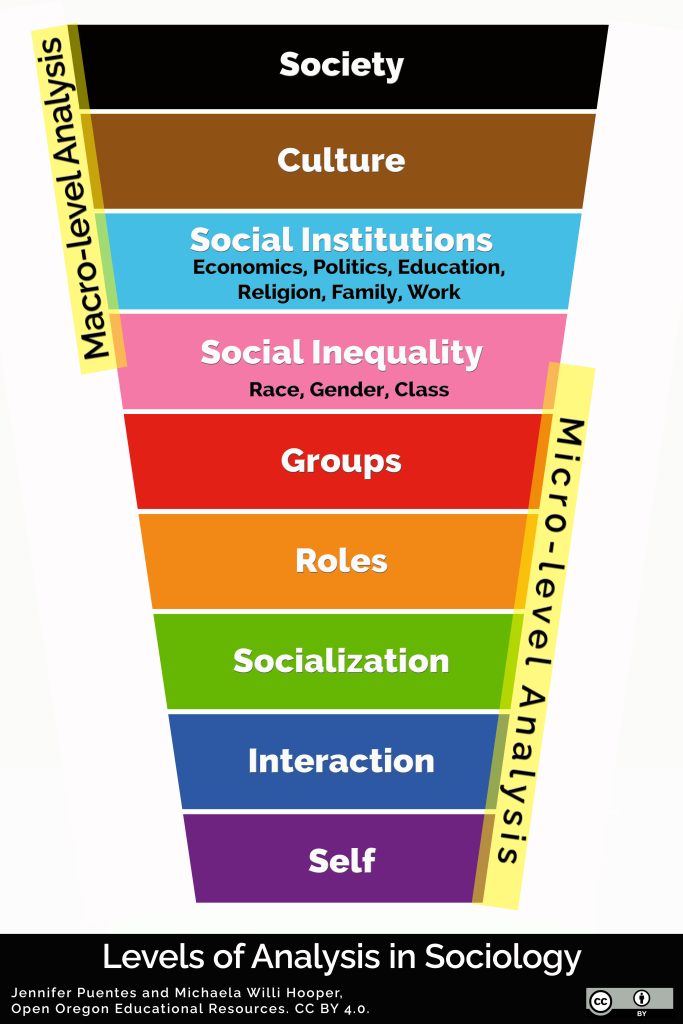1.4 Levels of Analysis: Macro Level and Micro Level
Sociologists study all aspects and levels of society. Levels of analysis in social sciences refers to the size or scale of the target research population. We tend to talk about this concept in terms of micro-level analysis (microsociology) and macro-level analysis (macrosociology). Figure 1.6 illustrates the main focal point of each level of analysis.
Sociologists working at the micro level study small groups and individual interactions. Micro-level analysis places a strong emphasis on context, meaning making, and interactions. It involves analyzing “what people do, say, and think in the actual flow of momentary experience (Collins 1981:984). As an example, a micro-level study might look at the accepted rules of conversation in various groups such as among teenagers or business professionals. You will learn more about this type of interaction in Chapter 4 and Chapter 5.
Sociologists who use macro-level analysis look at trends among and between institutions and societies and it emphasizes the influence of structures, institutions, and systems. The aspects of the society that are larger scale and exist over extended periods of time (Collins 1981). In contrast, a macro-level analysis might research how one institution impacts another, for example how religion influences politics.

Figure 1.6. Levels of Analysis: The Micro-Macro Continuum Figure 1.6 Image Description
1.4.1 Structure, Institutions, and Agency
In the social sciences, we examine the relationship between structure and agency to examine the influence on human behavior. Structure, sometimes called social structure, refers to the complex and stable framework of society that influences all individuals or groups through the relationship between institutions (e.g., economy, politics, religion) and social practices (e.g., behaviors, norms, and values). These patterned arrangements both limit and create opportunities for some individuals. Typically in the United States context, we see more opportunities for people who share similarities with those in positions of power.
Our social structure is made up of several institutions. Institutions or social institutions refer to a large-scale social arrangement that is stable and predictable, created and maintained to serve the needs of society. Our institutions are often interconnected; for example, economy, family, and education are separate social institutions that regularly intersect. Work opportunities that are available depend on the state of the economy and the access that individuals have to education. Our family arrangements, and socioeconomic status may create or limit opportunities to pursue higher education. You will learn more about social institutions that you encounter daily as we explore social inequalities in the chapters of this text that examine social class and stratification, race and ethnicity, gender, and sexuality. Additional information on education, religion, and health/medicine as social institutions can be found in Social Change.
Social structures and institutions have rules and norms that are semi-durable. They tend to be consistent and somewhat stable; however, social institutions are made up of individuals which means that there is some room for change over time. Agency tends to refer to the ability to make independent decisions, yet as sociologists we understand that the choices we have available to us are often limited by larger structural constraints. Sometimes our willingness to challenge norms and exhibit freewill overrides our needs to conform to social structures – particularly when a social structure feels too confining.
1.4.2 Licenses and Attributions for Levels of Analysis: Macro Level and Micro Level
Level of analysis definition adapted from Wikipedia is licensed under CC BY-SA 3.0
Figure 1.6. Levels of Analysis: The Micro-Macro Continuum
Structure definition from the Open Education Sociology Dictionary is licensed under CC BY-SA 4.0.
Social institutions definition from the Open Education Sociology Dictionary is licensed under CC BY-SA 4.0.
All other content in this section is original content by Jennifer Puentes and licensed under CC BY 4.0.
Image Description for Figure 1.6:
A colorful inverted triangle shows Society at the top, then Culture, then Social Institutions (including Economics, Politics, Education, Family, and Work), then Social Inequality (including Race, Gender, and Class), then Groups, then Roles, then Socialization, then Interaction, and at the very bottom, Self. Text and highlighting on the side of the pyramid indicates that Society, Culture, Social Institutions, and some aspects of Social Inequality are studied at the macro level of analysis. Self, Interaction, Socialization, Roles, Groups, and some aspects of Social Inequality are studied at the micro level of analysis.
[Return to Figure 1.6]
